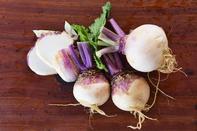Crop Rotation
Rotate turnips with non-Cruciferae family plants. A three-year rotation is advised. Alternatively, make sure that stringent risk mitigation practices regarding pests and diseases are applied.

Yield - tonnes per hectare
Conservative: 15 tonnes Average: 25 tonnes Good: 40 tonnesHarvesting
Harvesting of the turnip roots is done by hand or mechanical harvester. When harvesting the leaves, or turnip greens as they are referred to, cut away only the outer leaves so the remaining inner leaves can keep the plant growing.
Greens must be removed to a cool place with high relative humidity as soon as possible after cutting to prevent dehydration and wilting.
The roots are lifted and fine roots and the greens are cut away, leaving a stem of about 10 cm on the top of the turnip to reduce dehydration of the turnip before cooling.
Storage
Storage of turnip roots can be done at 0.5°C to 2°C and at a 95% relative humidity. Storage of turnip roots under these conditions can be done safely for up to four months.Pests
Common pests are Aphids, Cutworms, Diamondback moth, Nematodes, Root maggots, and Wireworm.Diseases
Some diseases to watch out for and do preventative measures against are, Blackleg fungus, Black root rot, Clubroot, Downey mildew, Loopers, Powdery Mildew, Rhizoctonia Rot, Rust and Sclerotinia.
It is always advisable to consult the local chemical representative and extension officer or agronomist on the best crop protection programs for the region or area that is to be cultivated.
By Louise Brodie